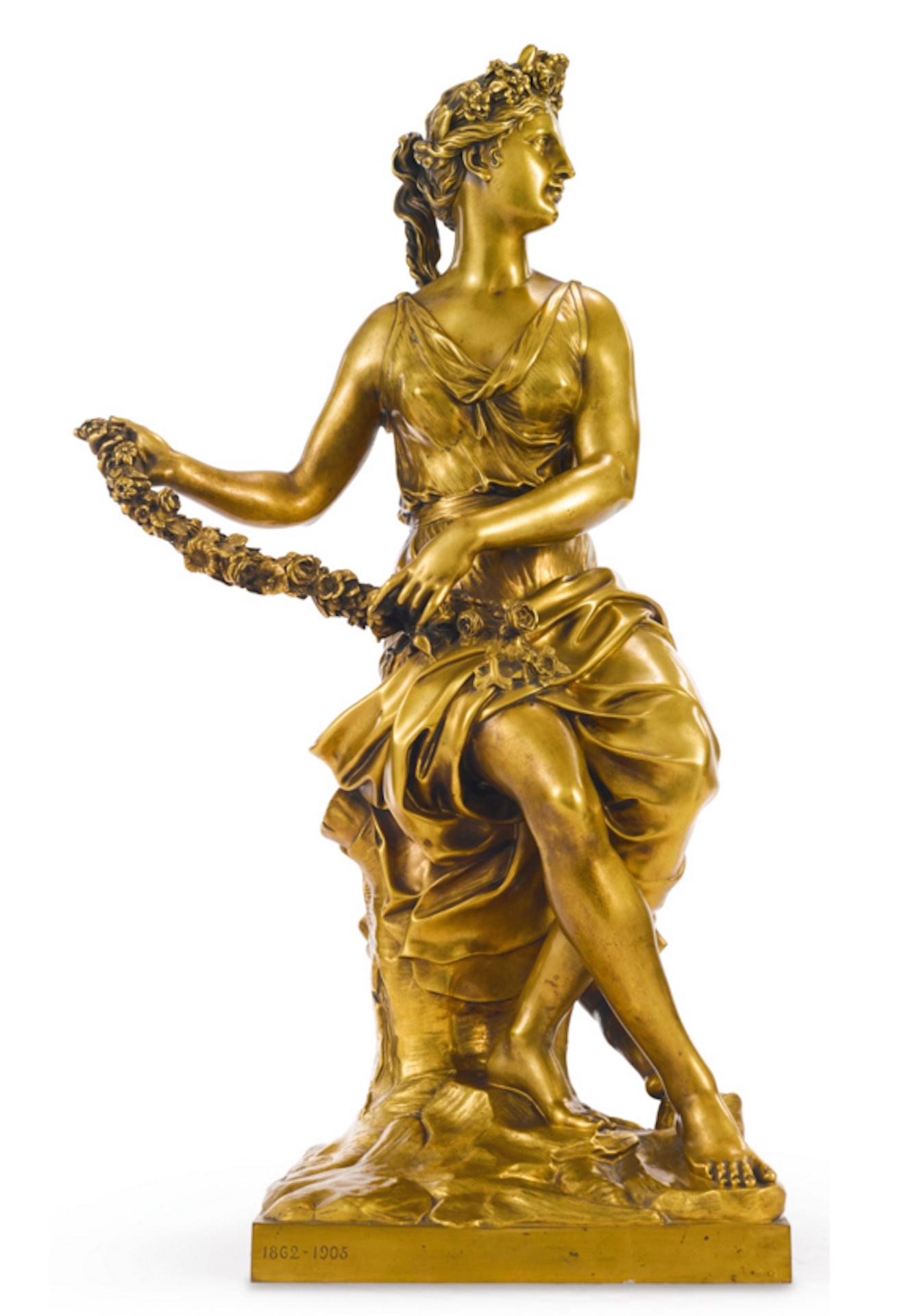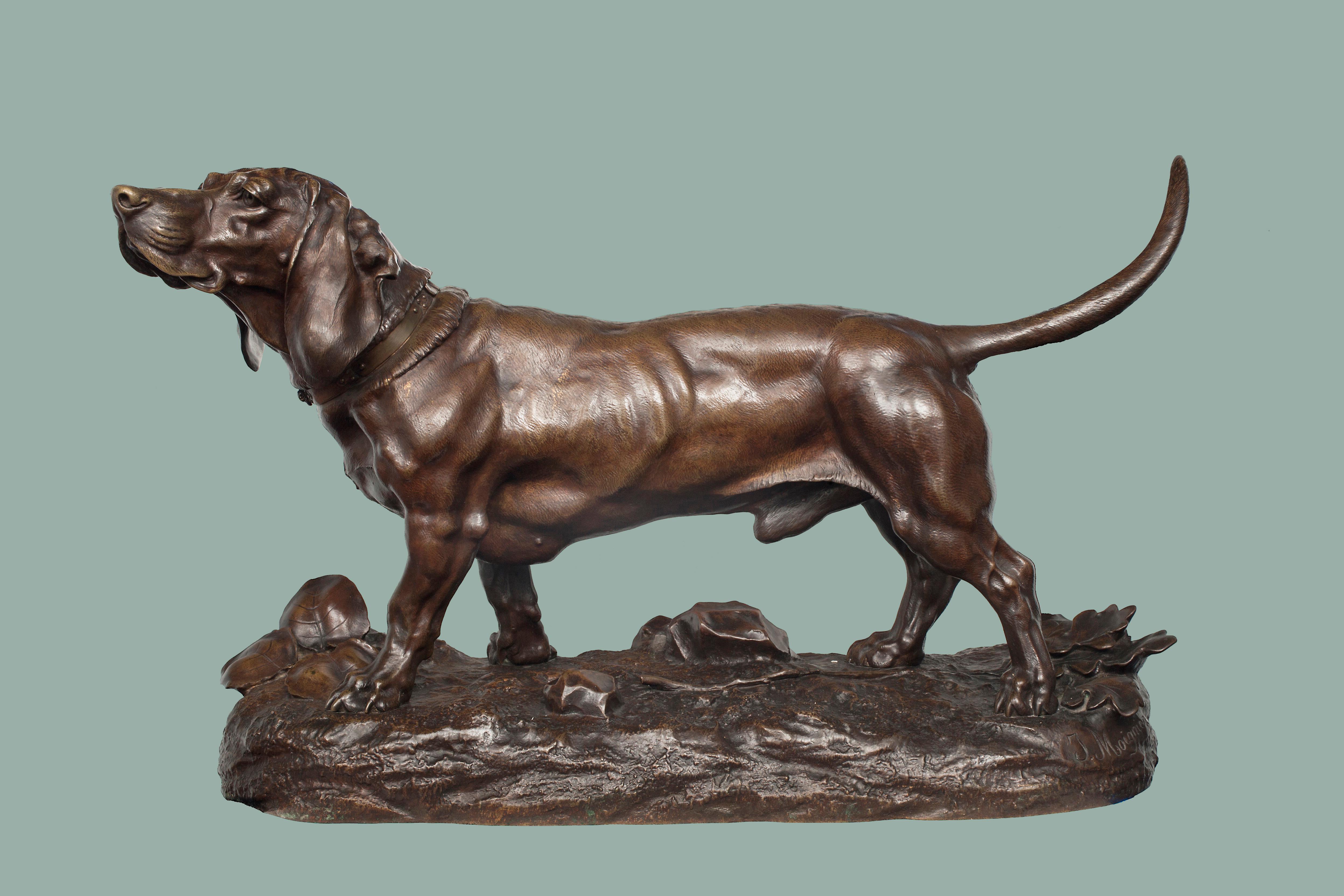Want more images or videos?
Request additional images or videos from the seller
1 of 12
Aimé-Jules DalouPavercirca 1890
circa 1890
About the Item
This paver is a subject that is included in the famous suite commonly called "little workers" by Jules Dalou (1838-1902)
Bronze with dark brown patina
cast by Susse Frères - stamped with the founder's seal
France
created around 1890 and cast after his death.
height : 15.8 cm
A similar model reproduced inJules Dalou, le sculpteur de la République, Exhibition held at the Musée du Petit Palais, Paris, 2013, page 247, n°175.
Biography :
Aimé-Jules Dalou, said Jules Dalou (1838-1902) was a French sculptor, born from Protestants glovers craftsmen who raised in secularism and love of the Republic. Jules Dalou was very young talented for modeling and drawing, which earned him the attention of Jean-Baptiste Carpeaux, who made him entered in 1852 in the Little School, the future National School of Decorative Arts in Paris. In 1854, he was admitted to the School of Fine Arts in Paris, where he studied painting in the workshop of Abel de Pujol and sculpture in the workshop of Francisque Duret. He began to earn his living by working for decorators, and began his friendship with Auguste Rodin. Dalou then produced decorative sculptures for buildings on major Parisian avenues, such as the Hotel de la Paiva, on the Champs-Elysees Avenue. He presented but failed four times to Rome prize competition, but exhibited at the 1869 Salon his "Daphnis and Chloe" and the "Embroiderer" at the Salon of 1870, two pieces acquired by the French state. Dalou had one child, Georgette, a girl born with a mental handicap. This is to ensure funding for her daughter's life accommodation in the Orphanage of Arts, that Dalou bequeathed the funds from his workshop to this institution.
After the bloody week of May 1871 Dalou, his wife and their daughter were threatened as Communards, forced into exile and requested asylum. They then joined England and were greeted by his former fellows of the Little School, the painter Alphonse Legros. With Legros, much introduced in the City, he made a serie of terracotta statuettes inspired by boulonnaise peasants or intimate subjects (readers, lullabies), and portraits of the English aristocracy. He became professor for modeling at the National Art Training School, his influence was decisive for many British sculptors. He received orders for a public fountain in marble titled "Charity" (1877) near the Royal Exchange in London, and a monument dedicated to Queen Victoria's grandchildren located in the private chapel of Frogmore at Windsor Castle.
In May 1874, the Paris War Council condemned him in absentia to hard labor for life. Having refused to beg for mercy, Dalou was only in May 1879 being granted amnesty and his family finally returned from exile. His group "The Triumph of the Republic", originally planned for the Place de la Republique in Paris, was finally erected on the Place du Trône, renamed Place de La Nation in 1880. Dalou devoted twenty years to the realization of this monument. The years 1881 and 1882 were difficult, but the 1883 Salon finally revealed him to the French public. He exhibited his two high reliefs: "The Brotherhood of Peoples" and "Mirabeau answering Dreux-Brézé", for which he was awarded the Medal of Honor. Fleeing the world and living in family, Dalou engaged in considerable work and many orders both private and public. For the Universal Exhibition of 1889, was inaugurated on the Place de la Nation the plaster of "The Triumph of the Republic" commissioned by the city of Paris in 1879. Although the bronze version of the group was inaugurated in 1899, this work won the grand prize for sculpture in the exhibition. Dalou left the French Society of Artists in 1890 to expose at the National Society of Fine Arts, of which he was a founding member with Ernest Meissonier, Auguste Rodin and Pierre Puvis de Chavannes. Awarded Knight of the Legion of Honor in 1883, and promoted to officer by President Carnot in 1889, he was elevated to the rank of Commander of the same order in 1899 by President Loubet at the inauguration of the monument of "The Triumph of the Republic".
Dalou had no time to complete his last great project, a monument dedicated to workers, the idea came to him in 1889 after the first opening of "TheTriumph of the Republic". The formality of the ceremony and military parades held the people away from the official event. Dalou was disappointed. True to its republican ideals, he had hoped that this inauguration was an opportunity of great popular democratic party (as it was at the inauguration of the bronze in 1899). His idea was then to pay tribute to the world of workers, craftsmen and peasants with this work being the central subject. At the end of his career Dalou described the project as follows: "I think I have finally found the monument to the workers that I seek since 1889. Sober, without molding or ornament, I wish it'd be severe and imposing. Will I execute it? There is the question. I am old and my health is so weak."
The numerous sketches of the monument found in his studio after his death are now preserved in the Musée du Petit Palais in Paris. The statue of the Great Peasant (around 1897 to 1902, Paris, Musée d'Orsay) prefigures the characters he planned to place in the sixteen niches surrounding the column, a monument of 32 meters high.
- Creator:Aimé-Jules Dalou (1838 - 1902, French)
- Creation Year:circa 1890
- Dimensions:Height: 6.23 in (15.8 cm)Width: 2.76 in (7 cm)Depth: 1.97 in (5 cm)
- Medium:
- Movement & Style:
- Period:
- Condition:
- Gallery Location:PARIS, FR
- Reference Number:

About the Seller
5.0
Vetted Seller
These experienced sellers undergo a comprehensive evaluation by our team of in-house experts.
Established in 1992
1stDibs seller since 2023
Typical response time: 1 to 2 days
- ShippingRetrieving quote...Ships From: PARIS, France
- Return PolicyA return for this item may be initiated within 3 days of delivery.
More From This SellerView All
- Bear BagpiperBy Christophe FratinLocated in PARIS, FRBear Bagpiper by Christophe FRATIN (1801-1864) Bronze with nuanced dark brown patina Signed on the base "Fratin" Old edition cast France mid-19th century height 10,5 cm Biography ...Category
Mid-19th Century French School Figurative Sculptures
MaterialsBronze
- Hay PickerBy Aimé-Jules DalouLocated in PARIS, FRThis Peasant resting is a subject that is included in the famous suite commonly called "little workers" by Jules Dalou (1838-1902) Bronze with nuanced dark brown patina cast by Susse Frères - stamped with the founder's seal France created around 1890 and cast after his death height 12,5 cm A similar model reproduced inJules Dalou, le sculpteur de la République, Exhibition held at the Musée du Petit Palais, Paris, 2013, page 288, n°220. Biography : Aimé-Jules Dalou, said Jules Dalou (1838-1902) was a French sculptor, born from Protestants glovers craftsmen who raised in secularism and love of the Republic. Jules Dalou was very young talented for modeling and drawing, which earned him the attention of Jean-Baptiste Carpeaux, who made him entered in 1852 in the Little School, the future National School of Decorative Arts in Paris. In 1854, he was admitted to the School of Fine Arts in Paris, where he studied painting in the workshop of Abel de Pujol and sculpture in the workshop of Francisque Duret...Category
Late 19th Century French School Figurative Sculptures
MaterialsBronze
- Hay BalerBy Aimé-Jules DalouLocated in PARIS, FRThis Hay baler is a subject that is included in the famous suite commonly called "little workers" by Jules Dalou (1838-1902) Bronze with dark brown patina c...Category
Late 19th Century French School Figurative Sculptures
MaterialsBronze
- Bearer of wheat sheavesBy Aimé-Jules DalouLocated in PARIS, FRThis bearer of sheave is a subject that is included in the famous suite commonly called "little workers" by Jules Dalou (1838-1902) Bronze with dark brown patina cast by Susse Frère...Category
Late 19th Century French School Figurative Sculptures
MaterialsBronze
- Roman driver on his chariotBy Emmanuel FremietLocated in PARIS, FREquestrian sculpture "Roman driver on his chariot" by Emmanuel Fremiet (1824-1910) Bronze with its original nuanced dark brown patina cast by MORE France circa 1880 height 41,5 cm l...Category
1880s French School Figurative Sculptures
MaterialsBronze
- Woman bringing back grassBy Aimé-Jules DalouLocated in PARIS, FRThis Peasant resting is a subject that is included in the famous suite commonly called "little workers" by Jules Dalou (1838-1902) Bronze with nuanced dark brown patina cast by Suss...Category
Late 19th Century French School Figurative Sculptures
MaterialsBronze
You May Also Like
- Flora et L'amour ou HamadryadeBy Ferdinand BarbedienneLocated in Tallinn, EEFerdinand Barbedienne (1810 - 1892) Antoine Coysevox, after (France, 1640-1720) Flora et L'amour ou Hamadryade Inscribed 'A. COYSEVOX. F. 1710'. With foundry mark 'F. BARBEDIENNE...Category
Late 19th Century French School Figurative Sculptures
MaterialsBronze
- A Basset HoundBy Jules MoigniezLocated in New York, NYinscribed J. Moigniez bronze with brown patina, cast during the artist’s lifetime height 18 1⁄2 inches (47 cm.), width 29 1⁄8 inches (74 cm.) PROVENANCE James Graham & Sons, Inc., N...Category
Late 19th Century French School Figurative Sculptures
MaterialsBronze
- Antique Silvered Bronze Rooster, France circa 19th CenturyLocated in SANTA FE, NMAntique Silvered Bronze Rooster France, circa 1900 10 1/4 x 9 1/2 (H x D) inches A very fine and lively bronze statuette of a preening Rooster. Nicely cast and well-carved and in ex...Category
19th Century French School Figurative Sculptures
MaterialsSilver, Bronze
- Antique Bronze Dog Portrait of a Cavalier King Charles "Thigley" circa 1905Located in SANTA FE, NMAntique Bronze Dog Portrait of a Cavalier King Charles "Thigley" French School (possibly Franck Burty Haviland) Lost wax bronze casting Circa 1910 5 7/8 x 9 x 3 1/4 A sophisticated bronze casting of a Cavalier King Charles spaniel made in lost wax casting (cire perdue) from the beginning of the 20th century by Valsuani Foundry. This an unusual bronze approached in its aesthetic that’s reminiscent of the work of great animal sculptors of the second half of the 19th century except in this presentation which is more avant-garde for the time with a much looser, more impressionistic execution. The patina is a superb bronze color, brown and slightly greenish, going in places towards a more antique green. The attitude of the dog is extremely well and sensitively rendered with the placement of material unlike the renderings of a bronze by Barye...Category
Early 1900s French School Figurative Sculptures
MaterialsBronze
- Antique French Grand Tour Gilt Bronze Statue on Column Diana the Huntress 1838By Ferdinand BarbedienneLocated in Portland, ORA fine & large (34" tall) antique French gilt-bronze on marble column of Diana, cast by Ferdinand Barbedienne (1810-1892) after a statue by Jean Antoine Houdon (1741-1828), the bronz...Category
1830s French School Figurative Sculptures
MaterialsMarble, Bronze
- RhinoBy Roland d'Andlau-HombourgLocated in Greenwich, CTBronze "Rhinoceros' by Roland d' Andlau-Hombourg (1927-2009) signed, numbered 1/6 with Godard foundry stamp R. d' Andlau was a gifted 'animalier' sculptor in the grand tradition ...Category
1950s French School Figurative Sculptures
MaterialsBronze
Recently Viewed
View AllMore Ways To Browse
Jules Dalou
Eilat Stone
15th Century Corpus
Rolex Lyon
Sailfish Painting
Saint Michel Et Le Dragon Bronze
Michael Wilkinson Sculptures Acrylic Sculpture
Pawel Orlowski
Nison Tregor
Northwest Native Ring
Paul Granlund Bronze Sculptures
Paul Granlund
Pippin Drysdale
Barnaby Barford Babel
Mireia Serra On Sale
Barford Babel
Barnaby Barford Apple
M L Snowden

